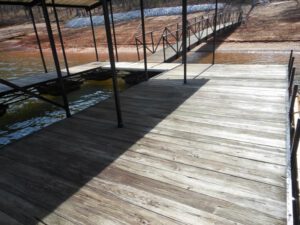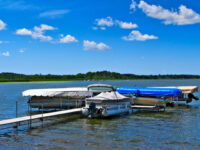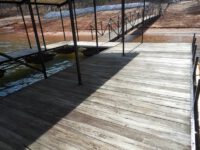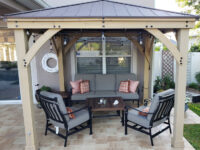When Dock Restoration Is Necessary
Sometimes, a dock is beyond repair and needs Dock Restoration. Splinters are a common problem on wood docks and can be prevented by regular cleaning, sanding, and staining. Rust stains can be cleaned with vinegar, but a heavy stain may require the replacement of metal components.
If rust occurs in multiple areas of your dock platform or support, it’s time for a replacement.

When a dock starts to show signs of deterioration, it is time to bring in the professionals. Some problems are easier to fix than others, and the cost of repair can also depend on how serious the damage is. For example, a dock with a damaged foundation should be replaced as soon as possible to avoid further deterioration and a potential collapse.
Wood rot is another common problem that affects the integrity of docks. Generally, this is a result of the water coming in contact with the wood over time and can be prevented by regularly inspecting and cleaning the dock, including the gangway. It is also a good idea to apply a stain or preservative to the wood on a regular basis, especially during the off-season. This can help prevent fungal decay and extend the life of the dock.
If a dock has metal components, it is important to look for rust spots on a regular basis. This is because metal doesn’t mix well with water, and it can cause the metal to corrode quickly. Rust spots can be easily removed with a bit of elbow grease, but if the entire dock is rusted, it may be best to consider a replacement.
A damaged or unstable dock can create safety hazards and be a nuisance for anyone who wants to spend time on or near the water. If you notice issues like warped wood, rotting boards, rusty metal, or other deterioration, Our team is knowledgeable and experienced in repairing all types of boat docks
Some of the more serious problems that warrant a call for a professional include a deteriorated foundation and extensive hurricane damage. These can be costly to fix, but they are necessary in order to keep your dock safe for use and in good condition for years to come. If you notice that the soil around your dock has been disturbed, this is a sign of foundation deterioration and should be addressed immediately. A qualified professional can determine the most effective solution for your situation, which might include piering or polyjacking.
If your dock is made of wood, it will inevitably rot at some point. Regular inspections are necessary to catch rotting spots, so that they can be repaired before it becomes an issue for the entire structure. Wood rot occurs when water seeps into the grain of the wood and eats away at it, turning it into a fungal mess. This is not only a serious problem for your dock’s structural integrity, but it also poses health issues for anyone who uses the dock because of bacteria and fungus that can affect the respiratory system.
One of the easiest ways to identify a rotting wood is by examining its color and texture. Rotten wood has a cottony texture and a grayish appearance that can be quite distinct from healthy wood. Upon further examination, wood pathologists can generally identify the type of fungus causing the rot. Lenzites saepiaria, a brown rot fungus, is often responsible for the rotting of docks and other structures that are exposed to water and sunlight.
When rot is discovered, it is necessary to replace the affected boards and beams with treated wood that has undergone preservation treatment to prevent future decay. This is a fairly simple process, though it will require some time for the new wood to dry before the structure can be used again. The wood may also need to be treated with a special antifungal solution, so it can withstand repeated exposure to the elements.
It is also a good idea to have any metal components of your dock inspected frequently for signs of rust. Salt water is corrosive to metal, and metal dock parts are often in direct contact with the water. This makes them a prime target for rust, especially if they are positioned in key load bearing areas of the dock. If rust spots are found, it is usually best to replace the metal component entirely to avoid an even bigger and costlier repair bill in the future. A full replacement may also be necessary if the component is in a position where it will interfere with the structural integrity of the dock.
A dock that is not properly maintained can become very dangerous for boat owners and even their guests. This is especially true if the auxiliary structures that make loading and unloading easier, like ropes, cables and rollers, start to break. These structures are holding a lot of weight and could snap with force, inflicting serious injuries to anybody on the boat who is not careful enough. This is why you should regularly check the auxiliary structures on your dock and replace them when they show signs of wearing out.
Another common issue with boat docks is that they may start to warp or bend due to the powerful forces they are exposed to from the waves. This is most often the case with crib docks and pile docks that are built on a sand bed where water can erode away the layers of sand underneath them, leaving the piles exposed. This can cause the entire dock to float and lose its anchorage in the ground, leading to it collapsing with a slight nudge.
Lastly, metal docks are susceptible to corrosion, especially if they are exposed to salt water for long periods of time. They can also rust and become weak if the connection points between the different parts of the dock are not sealed properly. Checking the connections on a regular basis is essential, especially since they are subjected to a lot of movement from boat trailers being driven back and forth on them every day.
It is important for traders to understand the concept of Support and Resistance. These are levels where prices tend to consolidate and investors begin to accumulate their positions. Eventually, it takes something big for them to move past these levels, which is why they are known as strong Support and Resistance levels. Weak Support and Resistance levels, on the other hand, are breached much more easily by prices. Traders should try to identify the strong ones before making their trades and use them as entry and exit points. They are a vital tool for the success of any trading strategy.
A dock’s foundation is what keeps the entire structure standing, so any cracking or sagging should be investigated immediately. If the cracks are widespread, the dock will likely need to be replaced. A sagging dock can cause dangerous conditions for boaters and may also be an indicator of larger problems with the foundation that need to be addressed as soon as possible.
Metal parts of the dock are especially prone to corrosion in salt water environments. It’s important to inspect these parts yearly for any signs of corrosion or other damage. If these metal components are completely covered in rust, the dock may need to be entirely replaced.
Wood rot is a common problem for docks, and it’s typically caused by a fungus that infiltrates the lumber. If the rotting is limited to a small section of the dock, it may be repairable with new treated wood. If the rotting is spread throughout the dock, however, it may be more economical to replace the entire dock.
Over time, the constant pressure on a dock can lead to warps and bends. If these are in the non-load-bearing supports of a dock, they can usually be repaired fairly easily. If the warps and bends are in the load-bearing support, however, it may be necessary to replace the entire dock.
Depending on the extent of the damage, it may be best to hire a professional to assess and determine how much work is needed to restore or replace the dock. This professional will also be able to provide recommendations on the necessary materials and tools for the repair or replacement.
There are many signs that a dock is reaching the end of its lifespan. If you’re noticing any of these critical warning signs, it’s probably time to hire a professional to inspect the dock and determine whether repairing or replacing it is the most cost-effective option. In addition to ensuring safety, addressing these issues early can help prevent more expensive repairs or even damage to surrounding property and the environment. By addressing any problems as they arise, you can ensure that your dock is safe and able to function properly for years to come.






